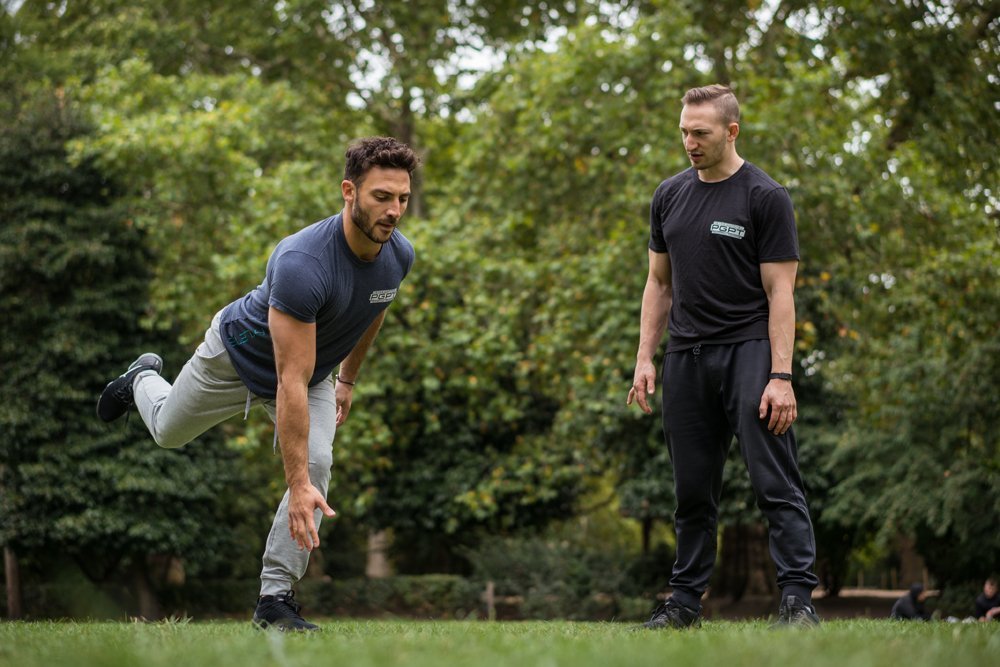WHO: Paul | Investments & Finance
AGE: 36
RESULTS: Ended chronic back pain
It was back in July that osteopath and Director of BodyMatters Clinic, Dr Oliver Thomson PhD referred Paul Babai to PGPT.
Below we have used Paul’s case to show the effectiveness of a collaborative between health and fitness professionals, combined with Paul’s determination to engage with our advice and for Paul to take charge of his own health.
Paul had been suffering from chronic back pain and sciatica for several years and opted for spinal surgery for a disc prolapse in July 2012. Despite the surgery being declared a success, he experienced continued back pain and stiffness and moved between a variety of health and fitness professionals, with little improvement.
In the summer of 2017, Paul was consulted by Dr Oliver Thomson who acknowledged that while Paul had a very painful back, there was no indication that there was any structure damage of his spine. His view was that Paul’s back was being sensitised by a range of different factors, including his previous spinal surgery, his fears and beliefs around his pain combined with a relatively poor physical conditioning. Dr Oliver was confident that with the right approach he could encourage Paul to think differently about his pain and begin to move in a relaxed and confident manner.

Fast forward seven months and Paul has been training with the PGPT team religiously twice a week. He has discovered not only a new-found sense of movement and strength but also unbelievable conditioning. If you were to see Paul for the first time today this is not a man you would have expected to have suffered disabling chronic lower back pain.
Dr Oliver’s message was clear to the PGPT team “It is all in your words”. He emphasised to the PGPT team that when Paul experiences pain, that this didn’t indicate his back was being harmed or damaged, and the pain would ease over time. The team took this onboard and reiterated this through the sessions with Paul. The power of one’s mind when it comes to back pain is quite extraordinary. It can literally make or break you. Paul would use terms like “my back is very vulnerable” or “I am so weak and suffer so much pain” that it was no surprise that Paul hadn’t seen any progress over resent years. This needed to change straight away. Dr Oliver said’ “we use words to construct meaning of our experiences”. Phrases such as “your back is weak, damaged and vulnerable” would cause Paul to fear his spine was being harmed when he felt pain and would feel threatened by movement. The PGPT team were then able to gradually expose Paul to a range of different movements, exercises and loads while using terms such as “your back is getting stronger” or “you can do this exercise”. As a result, Paul’s confidence increased, and the team the progressed increasing his performance of basic movements that he hadn’t done in such a long time like bending, squatting, twisting, pushing and pulling.
Along with the correct language, we were guided By Dr Oliver regarding which exercises might excessively be sensitise for Paul’s back and which exercises were more suitable. The ability of team PGPT and Dr Ollie to work closely together formed an effective support network for Paul. Initially, Paul was very rigid in his spine and hips, and lacked any sort of rotation. He sought to contract his abdominal muscles at the slightest movement (even when just standing still!)- The PGPT team felt this was in an effort to protect his back, which perceived to be vulnerable and fragile. The initial sessions focused on being able to put a joint through a greater range of movement than Paul had currently been doing (which wasn’t much). For example, a lunge with a rotation and a squat with a row. Paul surprised us all- he took onboard the advice and trusted in us all. As a result, his confidence in his back (and himself) improved dramatically. He was moving freely, confidently with little pain. Yes, there was the odd movement where he would feel a tweak or a shooting pain in his back but with time he realised that once he had acknowledged that it was present he could move on and keep exercising in a controlled manner as opposed to stopping and calling it a day.
On a personal note it’s been so rewarding to see Paul’s journey. He is by far one of the fittest PGPT clients. The sessions are varied, and his body has drastically changed. In terms of the progress Paul has gone from a body weight lunge to working with a kettlebell and doing some of the most complex movements out there (Turkish get up, snatches etc). What has been most rewarding was to see Paul’s mood and outlook change. From being a guy in his mid-thirty’s thinking he was done with exercise to seven months later being a guy who now has a quality of life (skiing trips, jogging and generally happy) its been such a success story.
My message with Paul’s case study can be summarised with five points.
- Find someone that can inspire you that it’s not all over
- Language is everything. A lot of it is in the mind so use the right words when talking about your back.
- There will be times when it will hurt, or you will tweak your back but that’s not a sign your back is damaged or harmed.
- Pain does not mean more damage
- Try a little more each day and your confidence will grow, and you should see your back pain subside.
To find out more about Dr Oliver Thomson and his approach to back pain and sciatic, click on the link https://www.droliverthomson.com/ and to see how PGPT can help visit www.pgpt.co.uk


